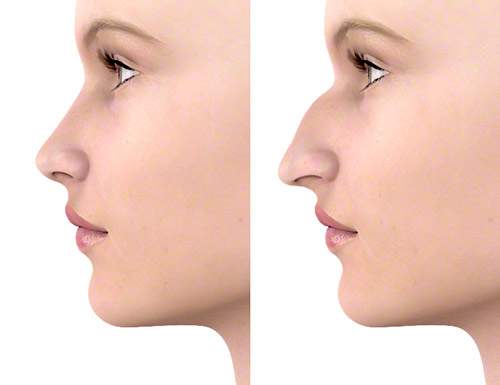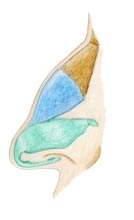Picture: Graphically you can see how different a profile of the same face can appear with an average nose shape and with a prominent long nose.
What is rhinomegaly?
In medical terminology, the diagnosis that makes a nose reduction appear sensible if the patient is suffering is called rhinomegaly (large nose) and attracts a lot of attention. Even an actually attractive face can appear unattractive due to a very large nose. In the majority of cases, a large nose is inherited. In rare cases, the cause is a proliferation of the sebaceous glands. This type of nasal deformity, which can take on grotesque forms, is called a bulbous nose by laypeople and rhinophyma by doctors.
To correct rhinomegaly, a classic nose correction operation, also known as rhinoplasty , can be performed as standard to reduce the size of the nose. You can find out more details in the following paragraphs.
Which structures are corrected during nose reduction?
If the nose is perceived as too large and a nose reduction is therefore desired, several structures are usually involved in this aspect.
- This means that the bridge of the nose is too wide and too high. The upper part consists of bone and the lower part of cartilage.
- The nose protrudes too far from the face. This is called too much projection.
- If it is more pronounced and the chin is also lowered, it is referred to as a bird’s face. In this case, a so-called profile correction is often recommended, in which a chin correction is performed at the same time as the nose reduction.
- The tip of the nose, which is often described as being too large or ‘knobbly’, is usually the result of a malformation of the structures of the nose (wing cartilage, etc.).
- The angle between the nose and the upper lip contour is also often too pointed, resulting in a drooping nasal tip (hooked nose).
- When the nose is reduced in size, this affects various structures. In addition to various bone structures, several cartilages must also be reduced. For example, when a nasal hump is removed, the nasal septum under the nasal hump is also reduced or chiseled smaller in order to achieve a straightening and reduction. In the case of crooked noses, the nasal septum must be straightened, as otherwise no acceptable cosmetic result can be expected. You can find more information on nasal septum surgery here.
Image: large cusp long nose with corresponding structures: green wing cartilage, blue triangular cartilage, brown bony nasal roof.
How is the nose reduction performed?
In the case of rhinomegaly, all causative components must be corrected. This always requires general anesthesia. The following steps must therefore be carried out during nasal reduction:
- Depression and narrowing of the bony and cartilaginous nasal roof.
- Shaping and, if necessary, reduction, lifting of the tip of the nose.
- As a large nose often also means large nostrils, these often have to be reduced in size in order to achieve an attractive result.
As the tip of the nose usually also needs to be corrected during a complete nose reduction, the operation is usually performed as an open rhinoplasty. A small W-shaped incision is made on the bridge of the nose between the nostrils in order to be able to operate openly on the tip of the nose. This facilitates the exact placement of sutures and enables precise incisions to be made on the cartilage.
It is not possible to reduce the size of the nose without surgery, as hyaluronic acid is usually used to conceal certain structures. This does not make the nose smaller!
Since the correction described on this page is a complete rhinoplasty, the costs for this operation tend to be in the higher price segment.
You can find further information on complications and details on the follow-up treatment for cosmetic nose surgery on the corresponding article pages. You are welcome to ask questions by email or make an appointment for a consultation so that we can show you some examples.
Sources:
- Rhinoplasty: An Atlas of Surgical Techniques – Daniel, Schlesinger – Springer; 1 edition – 2002
- Plastic surgery – Krupp – Ecomed – 2008 – (ring binder)



